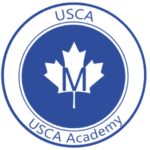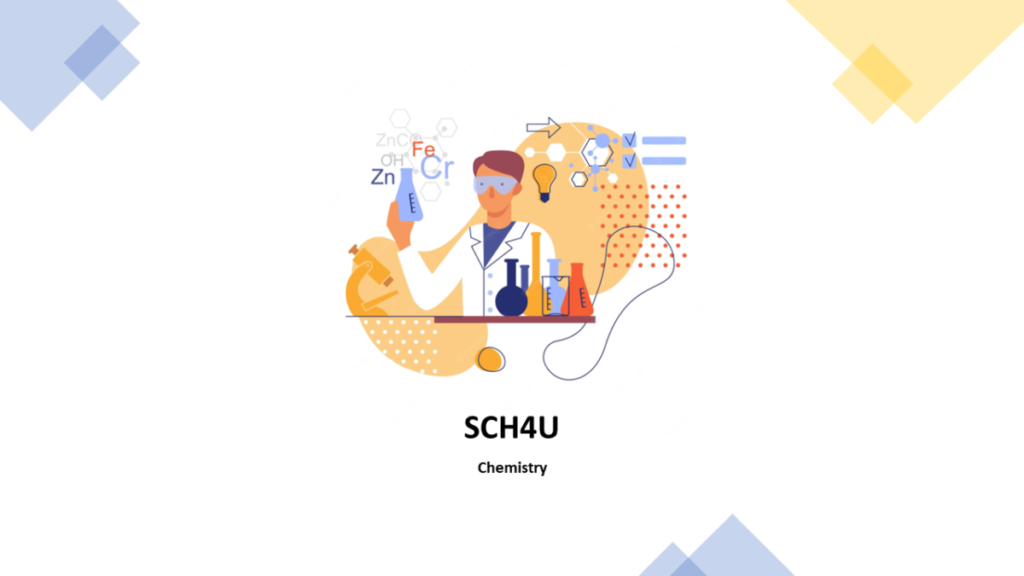SCH4U Course (Grade 12 Chemistry)
Send Us A Message
SCH4U - Grade 12 Chemistry
| Course Code: | SCH4U |
| Course Type: | University Preparation |
| Credit Value: | 1.0 |
| Prerequisite: | Chemistry 11, University Preparation, SCH3U |
Course Description For SCH4U Grade 12 Chemistry Online Course
This course, SCH4U Chemistry, is for the Grade 12 level where the student will build on their understanding of chemistry through the study of the nature of chemicals, the nature of chemical bonds and the measure of chemical reactions. Some of the course content will include; solutions, solubility, atmospheric chemistry and behavior of gases. In practical activities and calculations, students will improve their ability to examine the physical and chemical characteristics of substances. Also, the course examines the societal and environmental impacts of common chemical reactions, fostering a deeper appreciation for the role of chemistry in the world around us. For more details about the SCH4U – Chemistry Grade 12 course, feel free to contact us!
Overview Of Units And Timelines For Grade 12 Chemistry SCH4U
Here’s the suggested sequence for delivering course units, along with the recommended hours needed to complete each one. For a detailed breakdown of the specific expectations and activities included in each unit, refer to the Unit Overviews provided in the SCH4U course profile.
Unit
Titles and Descriptions
Time and Sequence
Unit 1
Review of Basic Chemistry
The purpose of this unit is to ensure that students have the necessary analytical, mathematic and communication skills necessary for success in this course. Review from prior courses, including nomenclature, the mole, types of reactions, and mathematical calculation and prediction of reaction products and reactants are surveyed.
7 hours
Unit 2
Organic Chemistry
Students will demonstrate an understanding of the structure, properties and chemical behaviour of compounds within each class of organic compounds. They will investigate organic compounds and organic chemical reactions, and represent the compounds in various ways. They will assess the social and environmental impact of organic compounds used in everyday life, and develop action plans to reduce the use of compounds that are harmful to humans and the environment.
20 hours
Unit 3
Structure of Matter
Students will demonstrate an understanding of atomic structure and chemical bonding, and how they relate to the physical properties of ionic, molecular, covalent network, and metallic substances. They will investigate the molecular shapes and physical properties of various types of matter. They will assess the benefits to society and evaluate the environmental impact of products and technologies that apply principles related to the structure of properties of matter.
20 hours
Unit 4
Energy Changes and Rates of Reactions
Students will demonstrate an understanding of energy changes and rates of reaction. They will investigate and analyse energy changes and rates of reaction in physical and chemical processes, and solve related problems. They will analyse technologies and chemical processes that area based on energy changes, and evaluate them in terms of their efficiency and their effects on the environment.
20 hours
Unit 5
Chemical Systems and Equilibrium
Students will demonstrate an understanding of the concept of dynamic equilibrium and the variables that cause shifts in the equilibrium of chemical systems. They will investigate the qualitative and quantitative nature of chemical systems at equilibrium, and solve related problems. They will analyse chemical equilibrium processes, and assess their impact on biological, biochemical and technological systems.
20 hours
Unit 6
Electrochemistry
Students will demonstrate an understanding of the principles of oxidation-reduction reactions and the many practical applications of electrochemistry. They will investigate redox reactions using a galvanic cell, and analyse electrochemical reactions in qualitative and quantitative terms. They will analyse technologies and processes relating to electrochemistry, and their implications for society, heath and safety, and the environment.
20 hours
Unit 7
Final Evaluation
The final assessment task is a three-hour exam worth 20% of the student’s final mark.
3 hours
Total
110 hours
Chemistry Grade 12 SCH4U: Throughout this course students will:
Problem solve: by developing, selecting, applying, and adapting a variety of problem-solving strategies
Reason and prove: by developing and applying reasoning skills to make mathematical conjectures, assess conjectures, and justify conclusions, plan and construct mathematical arguments;
Reflect: by monitoring their thinking to help clarify understanding as they complete an investigation or problem;
Select tools and computational strategies: by selecting and using a variety of concrete, visual, and electronic learning tools and computational strategies;
Connect: by relating mathematical ideas to situations or phenomena drawn from other contexts;
Represent: by making representations (e.g. Numeric, geometric, algebraic, graphical, pictorial and onscreen);
Communicate: by thinking orally, visually and in writing using precise mathematical vocabulary and conventions. Teachers will employ guided exploration, visuals, model analysis, direct instruction, problem posing and self-assessment to enable these student strategies.
Assessment is a systematic process of collecting information or evidence about a student’s progress towards meeting the learning expectations. Assessment is embedded in the instructional activities throughout a unit. The expectations for the assessment tasks are clearly articulated and the learning activity is planned to make that demonstration possible. This process of beginning with the end in mind helps to keep focus on the expectations of the course. The purpose of assessment is to gather the data or evidence and to provide meaningful feedback to the student about how to improve or sustain the performance in the course. Scaled criteria designed as rubrics are often used to help the student to recognize their level of achievement and to provide guidance on how to achieve the next level. Although assessment information can be gathered from a number of sources (the student himself, the student’s course mates, the teacher), evaluation is the responsibility of only the teacher. For evaluation is the process of making a judgment about the assessment information and determining the percentage grade or level.
Since the over-riding aim of this course is to help students use the language of mathematics skillfully, confidently and flexibly, a wide variety of instructional strategies are used to provide learning opportunities to accommodate a variety of learning styles, interests and ability levels.
The assessment will be based on the following processes that take place in the classroom:
| Assessment FOR Learning | Assessment AS Learning | Assessment OF Learning |
|---|---|---|
During this process the teacher seeks information from the students in order to decide where the learners are and where they need to go. | During this process the teacher fosters the capacity of the students and establishes individual goals for success with each one of them. | During this process the teacher reports student’s results in accordance to established criteria to inform how well students are learning. |
| Conversation | Conversation | Conversation |
| Classroom discussion Self-evaluation Peer assessment | Classroom discussion Small group discussion | Presentations of research Debates |
| Observation | Observation | Observation |
| Drama workshops (taking direction) Steps in problem solving | Group discussions | Presentations Group Presentations |
| Student Products | Student Products | Student Products |
| Reflection journals (to be kept throughout the duration of the course) Check Lists Success Criteria | Practice sheets Socrative quizzes | Projects Poster presentations Tests In Class Presentations |
Some assessment and evaluation strategies include:
| Strategy | Purpose | Who | Assessment Tool |
|---|---|---|---|
| Self-Assessment Quizzes | Diagnostic | Self/Teacher | Marking scheme |
| Problem Solving | Diagnostic | Self/Peer/Teacher | Marking scheme |
| Graphing Application | Diagnostic | Self | Anecdotal records |
| Homework check | Diagnostic | Self/Teacher | Checklist |
| Teacher/Student Conferencing | Assessment | Self/Teacher | Anecdotal records |
| Problem Solving | Assessment | Teacher | Marking scheme |
| Investigations | Assessment | Self/Teacher | Checklist |
| Problem Solving | Evaluation | Teacher | Marking scheme |
| Graphing | Evaluation | Teacher | Checklist |
| Unit Tests | Evaluation | Teacher | Marking scheme |
| Final Exam | Evaluation | Teacher | Checklist |
The evaluation of this course is based on the four Ministry of Education achievement categories of knowledge and understanding (25%), thinking (25%), communication (25%), and application (25%). The evaluation for this course is based on the student’s achievement of curriculum expectations and the demonstrated skills required for effective learning.
The percentage grade represents the quality of the student’s overall achievement of the expectations for the course and reflects the corresponding level of achievement as described in the achievement chart for the discipline.
A credit is granted and recorded for this course if the student’s grade is 50% or higher. The final grade for this course will be determined as follows:
- 80% of the grade will be based upon evaluations conducted throughout the course. This portion of the grade will reflect the student’s most consistent level of achievement throughout the course, although special consideration will be given to more recent evidence of achievement.
- 20% of the grade will be based on a final exam administered at the end of the course. The exam will contain a summary of information from the course and will consist of well−formulated multiple-choice questions. These will be evaluated using a checklist.
| Unit Number | Description | Evaluation Weight | KICA |
|---|---|---|---|
| Unit 1 | Strand 1: Scientific investigation skills and career exploration Strand 2: Forces, Work and Energy | Quiz 3% Total 14% | 25ƒ25ƒ25ƒ25 |
| Unit 2 | Strand 1: Scientific investigation skills and career exploration Strand 3: Energy and Momentum | Quiz 3% Total 14% | 25ƒ25ƒ25ƒ25 |
| Unit 3 | Strand 1: Scientific investigation skills and career exploration Strand 4: Electric, Gravitational and Magnetic Fields | Quiz 3% Total 14% | 25ƒ25ƒ25ƒ25 |
| Unit 4 | Strand 1: Scientific investigation skills and career exploration Strand 5: The Wave Nature of Light | Quiz 3% Total 14% | 25ƒ25ƒ25ƒ25 |
| Unit 5 | Strand 1: Scientific investigation skills and career exploration Strand 6: Revolutions in Modern Physics: Quantum Mechanics and Special Relativity | Quiz 3% Total 14% | 25ƒ25ƒ25ƒ25 |
| Culminating activity | 10% | 25ƒ25ƒ25ƒ25 | |
| Final Exam | 20% | 25ƒ25ƒ25ƒ25 | |
| Total | 100% | ||
| The percentage grade represents the quality of the students’ overall achievement of the expectations for the course and reflects the corresponding achievement as described in the achievement charts and will be 70% of the overall grade for the course; the Final evaluations will be 30% of the overall grade, incorporating a student/teacher conference and final exam. | |||
| Percentage of the Mark | Categories of Mark Breakdown | ||
| 70% | Assignments (25%) Tests (30%) Labs and Quiz (15%) | ||
| 30% | Culminating Activity (5%) and In Class discussion and presentations (Observations and Conversation (5%) Final Exam (20%) | ||
Main Resources: Textbook
Nelson Physics 12 University Preparation © 2012
Frequently Asked Questions (FAQ)
What topics are covered in the SCH4U Chemistry course?
The course covers chemical properties and bonds, chemical reactions, solutions and solubility, atmospheric chemistry, gases, organic chemistry, energy changes, equilibrium, and electrochemistry.
What are the prerequisites for enrolling in SCH4U Chemistry?
Students must have completed Chemistry 11 (SCH3U), a University Preparation course.
How is the SCH4U course assessed?
Assessments include assignments, quizzes, lab work, unit tests (70%), a culminating activity (5%), and a final exam (20%).
What skills will students develop in this course?
Students will enhance problem-solving, analytical thinking, and communication skills while understanding the societal and environmental impacts of chemical processes.
How long does it take to complete the SCH4U course?
The course is designed to be completed in 110 hours, including a 3-hour final exam.

